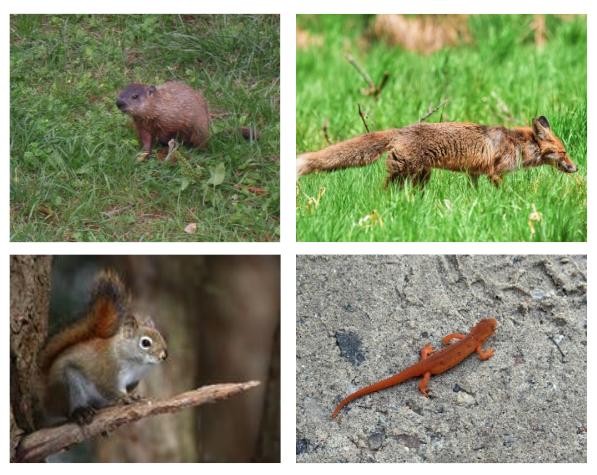The Fox
The first fox sighting seemed like a fluke. But then there was another. And another.
There have been more than three such sightings this year at WriCampia, all described similarly. Young, reddish orange, and possibly rabid, except for one, who was described as normal and not at all mentally ill. Most of these stories are about the “rabid” one, but we do think there are actually two foxes. We met with our friend, Senior Camper Catherine “Cate” S. first to talk about an interesting story she had about an encounter with a fox.
She and a few friends, Senior Campers Tallulah C-S., Asha H., were hanging out at the gazebo at around 10:30pm. It was dark, and they saw something moving in the shadows. It was a fox.
Usually, foxes are shy. But this fox was running in zigzags and trying to burrow in the ground. Seemingly rabid? Then it started heading towards them in the gazebo. Totally freaked out, they got out and started walking away. But the fox didn’t stop there – it started to follow them! This was unusual- foxes don’t often chase or attack humans. Their natural tendencies are to flee, even in threatening circumstances.
Eventually, Tallulah and Asha spotted Elsa and Joey in a golf cart. Cate and her friends warned them, but the fox had already noticed these new people. It started sprinting full speed towards them. Cate and Tallulah jumped on to the golf cart into Joey and Elsa’s arms as it sped off. Asha was left to run, and luckily was fine.
Joey, one of WriCampia’s golf cart drivers, offered a different perspective. He said that it “seemed like it wasn’t chasing us specifically but more like running in our general direction.” He also said that even though the fox probably had good intentions, it still “felt like a horror movie being chased by a blob you can’t fully see.”
After finishing telling me the story, Cate remarked, “It was insane, but lowkey trauma bonding.”
We then went to Tallulah, who told us how she had seen another fox on August 12th. But this one had not been acting weird, just hanging out on its own, uninterested in her.
One of our bunkmates, middle camper Julia V., also sighted a fox on August 14th. Foxes can normally adapt to the human population easily, but this one had not because it tried to follow her. Luckily, Julia made it back to her bunk in time. Stay safe out there! ✎
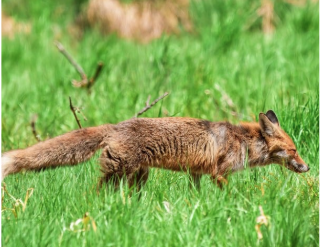
The Whistle Pig
Have you ever heard of the Whistle Pig? You probably know them as the groundhog, small rodents you might have seen scurrying around campus this year. The groundhog has been spotted over three times. Usually just chilling, eating grass by the lamp post near the theater, or underneath the stairs to bunk seventeen, hanging out with a bird on the steps.
The times you haven’t seen them they were probably either hibernating, or burrowing underground, which helps oxygen circulate and drain. When they go underground, they usually bring plants or flowers with them, so they can use it for bedding, which also ends up decomposing, improving the soil’s health.
Groundhogs are actually pretty intelligent. They communicate through whistling— hence the nickname. They also form complex social networks.
Groundhogs are primarily herbivores, meaning they eat plants, vegetables, and fruits. However, many animals eat them, like, coyotes, foxes, hawks, and owls. Poor little Whistle Pigs. ✎
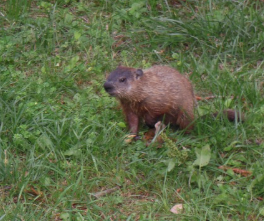
The Red Eft
Red efts, or Notophthalmus viridescens are small newts that have three life stages: the aquatic larvae stage, the terrestrial red eft, and the aquatic adult stage. The red efts you’ll see around camp are in their juvenile, terrestrial stage.
They are small, red, and toxic to eat. Their bright red color serves as a warning to predators not to eat them. Other species, like the red salamander, imitate red efts coloring to avoid being preyed upon. Sometimes this warning doesn’t work; red efts are eaten by birds, fish, and other amphibians.
Red efts are mostly found in the late summer and early fall, often after a rain. They like to hang out under leaves and logs, anywhere dark and moist. They’re less than five inches in length, which makes it easier for them to hide in their favorite spots.
If you see a red eft around camp, don’t pick it up. The oils on your skin are toxic to them. Just let it go on its way as it pleases. ✎
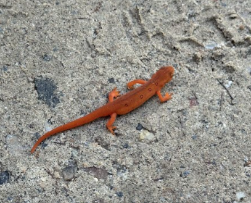
The Canada Goose
The Canada goose is one of the more hostile animals we have at WriCampia. They’re known to chase humans and sometimes bite. But, it’s all with good intentions. Geese are very protective of their families. They have been known to risk their lives to protect their children and mates. Canada geese will mate for life, often finding a partner at two or three and staying together for the remaining years of their life. If the mate dies, the other will usually find a new pair. They can be annoying, though. They poop all over our lawns, which is very inconsiderate. But, they were here first, so we can’t get too mad.
Even though they’re nice to their mates, they won’t be nice to you. If you see a goose, do not approach it, because it will surely mess you up. So, be nice to the geese. And give them space. ✎
The Red Squirrel
Red squirrels (Sciurus vulgaris) are a small, native species of tree squirrel. They have fluffy, pointed ears that are especially prominent in winter. They are solitary animals and very territorial. But, apparently not over their mates, because they’re polygynandrous (both males and females have multiple partners).
Red squirrels really enjoy chewing on anything they need to make a comfortable nest. They like making nests in not only trees, but also attics and walls. Maybe they’re jealous of our luxuries… ✎
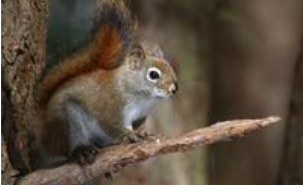
The Bear
Many of you who were here last year will remember the bear roaming around campus, named by the campers and counselors, “Lil Timmy.” Sadly (or happily?), we have not had any more sightings of the bear at camp. But, we have seen a mother and young bear only a few miles away.
Massachusetts is actually known as “bear country”. If you see a bear here, it’s probably a black bear, a species that is very common in western and central Massachusetts. Black bears are generally not considered aggressive towards humans, but they may be unpredictable. But, don’t worry, there’s only a 1 in 2.1 million percent chance of being actually attacked by a bear.
Weirdly enough, though bears can chomp through bone and eat foxes, they’re afraid of dogs.
Black bears are the smallest and most common bear species in North America. Their furs are also not always black. Black bear cubs can weigh less than one pound at birth. However, when they are adults they are five to seven feet when standing. You might not have guessed, but they’re actually solitary animals. Additionally, they are good swimmers and climbers. In the wild, they can live over twenty-two years. Just remember this saying if you ever see a bear, “If it’s brown, lay down. If it’s black, fight back. If it’s white, goodnight.”
Some of these animals may seem scary, but as long as we don’t leave food or trash out, and we follow protocol, we’ll be fine. These are the animals we saw or heard about at camp, what about you? Tell us next year in “The Daily WriCampian.” ✎

